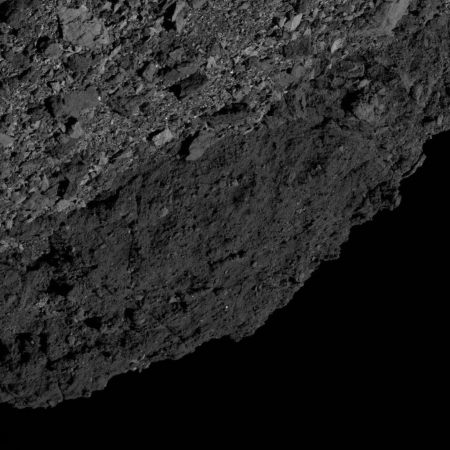Bennu’s cobbled equatorial ridge
The OSIRIS-REx science team has released a new close-up image of Bennu, this time showing the asteroid’s equatorial ridge. The image on the right is that photograph, reduced to post here.
When the image was taken, the spacecraft was positioned over Bennu’s northern hemisphere, looking southward over the asteroid’s equatorial bulge. The field of view shown is 168 ft (51.2 m) wide. For scale, the bright, rectangular rock above the dark region is 8 ft (2.4 m) wide, about the size of a long bed on a pickup truck
Like Ryugu, the scientists for OSIRIS-REx are going to be challenged in finding a location smooth enough for their touchdown sample grab. That surface reminds me of some avalanche scree slopes I’ve hike across, where you’ve got nothing but rough rocks to walk on.
On Christmas Eve 1968 three Americans became the first humans to visit another world. What they did to celebrate was unexpected and profound, and will be remembered throughout all human history. Genesis: the Story of Apollo 8, Robert Zimmerman's classic history of humanity's first journey to another world, tells that story, and it is now available as both an ebook and an audiobook, both with a foreword by Valerie Anders and a new introduction by Robert Zimmerman.
The print edition can be purchased at Amazon or from any other book seller. If you want an autographed copy the price is $60 for the hardback and $45 for the paperback, plus $8 shipping for each. Go here for purchasing details. The ebook is available everywhere for $5.99 (before discount) at amazon, or direct from my ebook publisher, ebookit. If you buy it from ebookit you don't support the big tech companies and the author gets a bigger cut much sooner.
The audiobook is also available at all these vendors, and is also free with a 30-day trial membership to Audible.
"Not simply about one mission, [Genesis] is also the history of America's quest for the moon... Zimmerman has done a masterful job of tying disparate events together into a solid account of one of America's greatest human triumphs."--San Antonio Express-News
The OSIRIS-REx science team has released a new close-up image of Bennu, this time showing the asteroid’s equatorial ridge. The image on the right is that photograph, reduced to post here.
When the image was taken, the spacecraft was positioned over Bennu’s northern hemisphere, looking southward over the asteroid’s equatorial bulge. The field of view shown is 168 ft (51.2 m) wide. For scale, the bright, rectangular rock above the dark region is 8 ft (2.4 m) wide, about the size of a long bed on a pickup truck
Like Ryugu, the scientists for OSIRIS-REx are going to be challenged in finding a location smooth enough for their touchdown sample grab. That surface reminds me of some avalanche scree slopes I’ve hike across, where you’ve got nothing but rough rocks to walk on.
On Christmas Eve 1968 three Americans became the first humans to visit another world. What they did to celebrate was unexpected and profound, and will be remembered throughout all human history. Genesis: the Story of Apollo 8, Robert Zimmerman's classic history of humanity's first journey to another world, tells that story, and it is now available as both an ebook and an audiobook, both with a foreword by Valerie Anders and a new introduction by Robert Zimmerman.
The print edition can be purchased at Amazon or from any other book seller. If you want an autographed copy the price is $60 for the hardback and $45 for the paperback, plus $8 shipping for each. Go here for purchasing details. The ebook is available everywhere for $5.99 (before discount) at amazon, or direct from my ebook publisher, ebookit. If you buy it from ebookit you don't support the big tech companies and the author gets a bigger cut much sooner.
The audiobook is also available at all these vendors, and is also free with a 30-day trial membership to Audible.
"Not simply about one mission, [Genesis] is also the history of America's quest for the moon... Zimmerman has done a masterful job of tying disparate events together into a solid account of one of America's greatest human triumphs."--San Antonio Express-News



Stupid question. How do scientists determine north and south on objects like this?
Darwin Teague: That is not a stupid question, it is brilliant. I myself had never asked, which means I don’t really know.
I think, based on past reading of both these asteroid missions as well as others, that they use the asteroid’s rotation to determine the locations of the poles and equator, and then pick north based on its relative location compared to the Earth. In other words, they match the asteroid’s rotation with the solar system, and have north point away in the same direction as the Earth.
This is an educated guess however.
Robert, if the asteroid had a retrograde rotation, would that place the north pole in the same direction as Earth’s south pole? Looking this up, I see Venus and Uranus have retrograde rotation but it’s unclear which side is designated north. This question is explored at the following URL, but with no clear answer:
https://forum.cosmoquest.org/showthread.php?138723-Which-way-is-North-on-Venus
Or, even a more in-depth discussion here on the same topic:
http://esr.ibiblio.org/?p=5324
Seems Darwin’s question is indeed a very good one.
Especially since Uranus has a 98-degree tilt to its axis. That would imply that “north” is in a southerly direction compared with Earth.